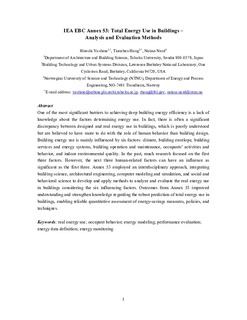| dc.contributor.author | Yoshino, Hiroshi | |
| dc.contributor.author | Hong, Tianzhen | |
| dc.contributor.author | Nord, Natasa | |
| dc.date.accessioned | 2017-11-13T09:19:36Z | |
| dc.date.available | 2017-11-13T09:19:36Z | |
| dc.date.created | 2017-09-18T15:32:12Z | |
| dc.date.issued | 2017 | |
| dc.identifier.citation | Energy and Buildings. 2017, 152 124-136. | nb_NO |
| dc.identifier.issn | 0378-7788 | |
| dc.identifier.uri | http://hdl.handle.net/11250/2465702 | |
| dc.description.abstract | One of the most significant barriers to achieving deep building energy efficiency is a lack of knowledge about the factors determining energy use. In fact, there is often a significant discrepancy between designed and real energy use in buildings, which is poorly understood but are believed to have more to do with the role of human behavior than building design. Building energy use is mainly influenced by six factors: climate, building envelope, building services and energy systems, building operation and maintenance, occupants’ activities and behavior, and indoor environmental quality. In the past, much research focused on the first three factors. However, the next three human-related factors can have an influence as significant as the first three. Annex 53 employed an interdisciplinary approach, integrating building science, architectural engineering, computer modeling and simulation, and social and behavioral science to develop and apply methods to analyze and evaluate the real energy use in buildings considering the six influencing factors. Outcomes from Annex 53 improved understanding and strengthen knowledge regarding the robust prediction of total energy use in buildings, enabling reliable quantitative assessment of energy-savings measures, policies, and techniques. | nb_NO |
| dc.language.iso | eng | nb_NO |
| dc.publisher | Elsevier | nb_NO |
| dc.rights | Attribution-NonCommercial-NoDerivatives 4.0 Internasjonal | * |
| dc.rights.uri | http://creativecommons.org/licenses/by-nc-nd/4.0/deed.no | * |
| dc.title | IEA EBC annex 53: Total energy use in buildings - Analysis and evaluation methods | nb_NO |
| dc.type | Journal article | nb_NO |
| dc.type | Peer reviewed | nb_NO |
| dc.description.version | acceptedVersion | nb_NO |
| dc.source.pagenumber | 124-136 | nb_NO |
| dc.source.volume | 152 | nb_NO |
| dc.source.journal | Energy and Buildings | nb_NO |
| dc.identifier.doi | 10.1016/j.enbuild.2017.07.038 | |
| dc.identifier.cristin | 1494935 | |
| dc.relation.project | Norges forskningsråd: 268248 | nb_NO |
| dc.description.localcode | © 2017. This is the authors’ accepted and refereed manuscript to the article. LOCKED until 18.7.2109 due to copyright restrictions. This manuscript version is made available under the CC-BY-NC-ND 4.0 license http://creativecommons.org/licenses/by-nc-nd/4.0/ | nb_NO |
| cristin.unitcode | 194,64,25,0 | |
| cristin.unitname | Institutt for energi- og prosessteknikk | |
| cristin.ispublished | true | |
| cristin.fulltext | original | |
| cristin.qualitycode | 2 | |

